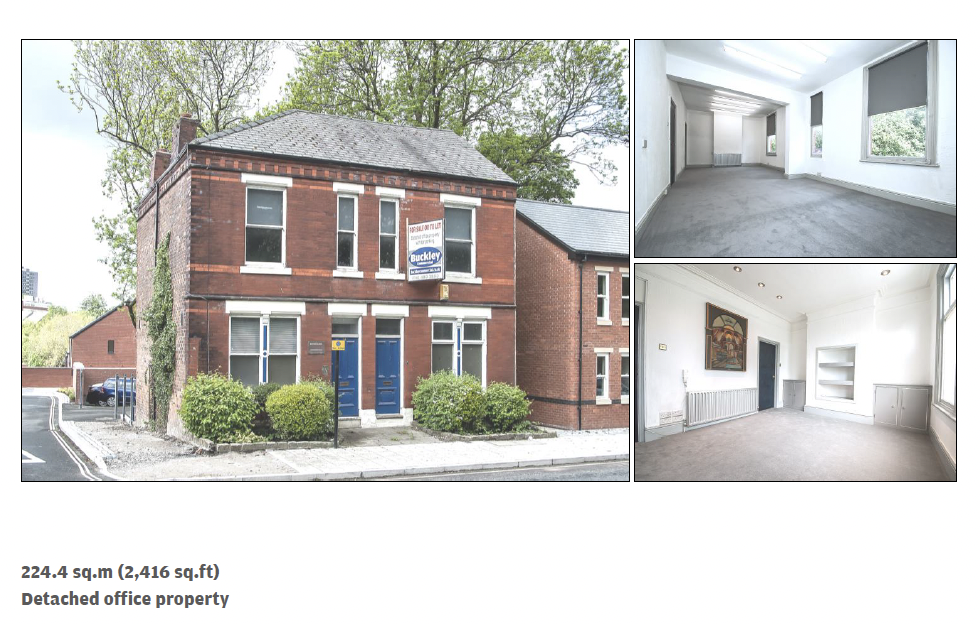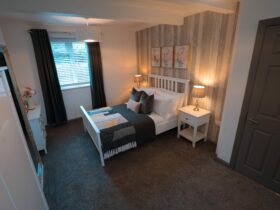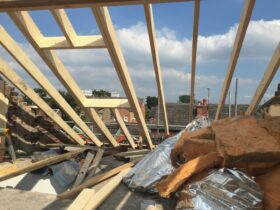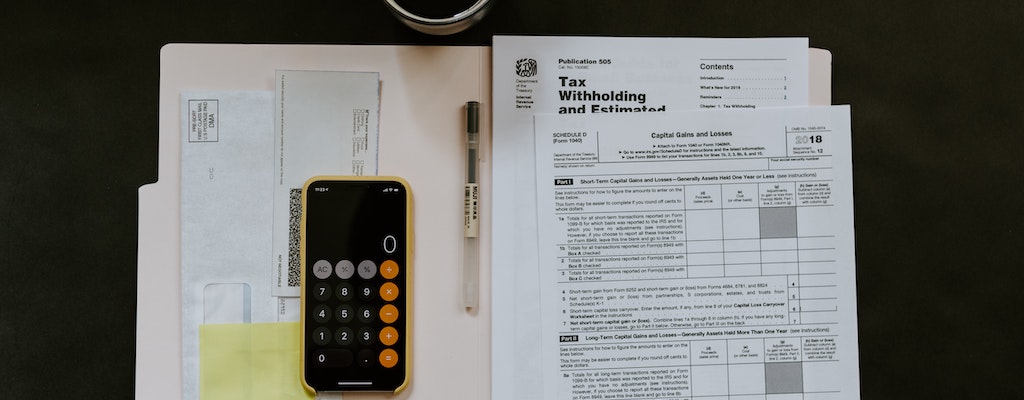Today I’m going to talk you through the essentials that you need to know about buy-to-let property investment.
I guess you’re here because you want to generate an income now or for the future, and you think that buy to let investing might be the answer?
It can be a hugely profitable investment strategy if done right, and whilst it’s simple on the surface, the devil is in the detail.
So let’s get you started with this definitive guide to buy to let investing.
What is buy to let property investing?
Buy-to-let property investment is a term used in the UK to describe the purchase of a property specifically to rent it out.
We’re not just talking about houses, or renting to a single family, although these are some of the most common options.
Buy to let investing could include a whole host of different property types, as well as a range of different tenants.
I’ll cover these in more detail later in this section.
But first, let’s talk about the main thing most of us are doing this for – money!
The core idea behind buy to let investing is simple.
Buy a property and rent it out for more than your costs in order to make a profit.
The average net yield on UK residential rental property is estimated to be around 3.7% (as of October 2022) but is this worth getting excited about?
I’m not a huge fan of yield based calculations. Gross yield doesn’t factor your running costs into the equation, and net yield is more representative but doesn’t allow for one of the biggest benefits of buy to let property…
LEVERAGE!
This mean that, unlike virtually any other investment you might be considering, you don’t need 100% of the property purchase price in order to invest.
Anyone with a half decent credit score can call up a mortgage broker and get a loan of 75% of the purchase price, which means your profit from 100% of the property only requires 25% of the value as a deposit.
That’s leverage, and it will considerably boost your investment return.
But we’re getting ahead of ourselves.
Let’s get back to basics:
The most common property types for buy to let investing
Buy to let investing goes beyond just houses, although they are the most common property investment in the UK. Here are the 4 most common properties you might want to consider for your next investment.
Houses
The most common type of rental property is a house. Houses can come in all shapes and sizes, from small bungalows to large mansions and are popular everywhere from city centres to rural locations.
Apartments
Apartments are probably the next most popular property type, for both buy to let investors and tenants. They’re most often located in urban areas, and are among the the cheapest investment options.
Apartment blocks
Rather than own a single apartment in a building, you could invest in entire blocks of flats (either buying them, or building them) which can give significant economies of scale.
Commercial property
This can include offices, retail stores, warehouses and industrial buildings. Commercial property is usually rented by businesses rather than individuals, and despite being overlooked by new investors, can still make a great investment property.
Mixed use
These are properties where there is both a commercial element as well as residential units within the same building. This might be flats above a shop or a HMO above a retail unit, for example.

It’s a popular way for experienced investors diversifying their buy to let portfolios.
The most common tenant types for buy to let property
And along with multiple property options, you’ve also got multiple tenants you might want to focus on.
Financially Independent Tenants
As ‘politically correct’ a term as we could think of for people who pay their rent via their own financial means. They don’t necessarily need to by employed – they could be retired, self-employed, or have won the lottery. But they are able to support themselves financially without any government support.
Tenants in receipt of housing benefits
Did you know, almost 3 million people receive some form of housing benefits in the UK? That’s a huge number of people that you could potentially house in your rental properties. Horror stories abound, so tread carefully, but many investors successfully focus on this group (and excluding them could pose a legal problem for you)
Local authorities & housing associations
With the shortage of affordable housing across most of the UK, many local authorities and housing associations will lease your property from you, and then sublet it to a resident who needs housing.

The rent probably won’t be the highest figure you could achieve, but it’s guaranteed, and usually for a period of 3-5 years, giving you a very hands-off income.
Charities
Charities are also looking for housing for the people they support, and will work with you on a similar basis to local authorities, but often have higher budgets for lease payments due to the lack of housing supply.
Businesses
Particularly if you go down the commercial property route, it’s possible you’ll end up with a business as a tenant rather than an individual. It’s a more specialist market and it’s critical to get the right property in the right location in order to secure the best rent, but leases are usually longer term, with more flexibility for landlords to evict bad tenants, and more responsibility on the tenant to maintain the property and contribute to things like the buildings insurance.
Other buy to let terms to be familiar with:
As you enter into the world of property investing, you’ll be bombarded with terms and acronyms – R2R, BRR, OIEO, PLO, etc.
Most of them will serve more to confuse you than help you in the early days, so don’t get bogged down trying to memorise what can feel like a whole new language.
Here are some of the most common terms you might come across, to help you get started.]
Single Let
A house or apartment purchased as an investment to be rented out to a single tenant (an individual or family unit) on a single AST (assured shorthold tenancy agreement).
Properties within this category tend to be 2-3 bedroom homes or 1-2 bedroom flats, but they could, of course, be any type or size of property in theory.
HMO (house of multiple occupancy)
Residential property that is rented out on a room by room basis to multiple tenants (usually on individual tenancy agreements) rather than as a single property.

These are often considerably more profitable than single lets, but require more expertise and effort to operate successfully.
You can read our detailed guide to HMO investments here.
Serviced Accommodation
A house or apartment (or a yurt, teepee, lodge, or whatever else people might want to stay in) that’s rented out on a short term contract.

Think of Airbnb, but guests can sometimes stay for weeks or months instead of days, and it’s not just holiday-makers.
Guests could be travelling for work, to visit friends or family, or need somewhere to live short term for a number of reasons.
Build to Rent
A take on buy to let investing, where instead of buying existing residential property to rent out, you instead create new property. This is usually done via new construction, but can also be done through conversions of non-residential property, like offices, into houses or flats. Arguably, this is a more sustainable way to invest as new homes are being created, rather than just moving existing homes from owner-occupied to rented.
Rent to Rent
Let’s be honest for a moment, if you’re here looking for get-rich-quick schemes, you’re in the wrong place (we firmly believe property can create the life you want to achieve, but it’s a slow process). Rent to rent is a valid investment option, but is often viewed as a shortcut. It involves a contract between the property owner and the rent to rent operator, who pays a guaranteed rent to the owner, and tries to make a profit by renting the property for a higher amount (often by operating it as a HMO or serviced accommodation).
The benefits of buy to let property investment
There are numerous benefits to owning investment property, but we don’t need to pore over every last detail.
Let’s just focus on the major benefits, as there should be more than enough here to get you excited about investing in property.
Rental Income
First and foremost, buy to let property should give you a relatively stable income.
There will be ups and downs, but generally speaking, the income you can generate from each property should be easy to estimate.
Putting aside a contingency for voids and maintenance every month will give you a buffer if things do go wrong.
And although it’s difficult to generalise, even a basic single let should generate at least £200 to £300 pre-tax profit every month (with some investment options able to return significantly higher profits).
Capital Appreciation
In addition to the regular income, if you own property for the long term (we rarely flip houses or ‘trade’ property – that’s a different strategy altogether), the chances are that it’ll go up in value.
Of course there are highs and lows in the market, but overall, house prices are heading in one direction in the UK.

Whether your property will double in value over 10 years (as the industry cliche goes), nobody can tell, but there’s a very good chance it’ll be worth more by then than it is now.
That allows you to sell for a profit, refinance to free up capital for further investment, or simply reduce your mortgage loan to value and benefit from more favourable interest rates.
Renovation Profits
We certainly don’t bank on capital appreciation (in our eyes it’s a bonus rather than a certainty), but what we can bank on is the increase in value that comes from renovating a property.
Whether it’s a simple DIY cosmetic uplift or a full scale renovation, we’re confident we can create value through good design and hard work.
The average value of property in the UK is £2,954 per square meter, while renovation and constructions costs are considerably less than this.
This means we can invest in a property to create a great place for our tenants to live, and get an immediate return on that investment in the way of a higher property valuation.
Inheritance Planning
Buy to let property can also be one of the most effective ways of creating wealth not just for yourself, but for future generations of your family as well.
It’s always worth speaking to a professional financial advisor or tax expert, but creating a portfolio of investment property knowing that your children and their children can benefit as well makes it feel even more worthwhile.
Limited Expertise
I don’t want to give the impression that property investing is easy!
My top tip is always to become the expert in whatever you are doing – the location you invest in, the type of property, the tenants you serve, etc – but in comparison to lots of other investments you might be considering, buy to let property is relatively easy to understand.
The main considerations are finding the right house at the right price, in the right location, and selecting the right tenants.
It’s no walk in the park, but compared to understanding complex financial statements of FTSE 100 companies or tracking the drivers of international currency markets, you probably already have an idea of the basics from buying your own home.
Make a Positive Difference
This final benefit is often overlooked, but buy to let property investing also allows you to make a positive difference.
Creating a nice place for someone to live, and being a ‘good’ landlord is not a given in this industry.

Sure, you’re in it to make a profit, but you can do this whilst still maintaining your properties to a good standard and being a reasonable human being when dealing with your tenants.
Providing a safe and comfortable place to call home can have a huge impact on someone’s life.
And not only that, but as your expertise grows, moving towards build to rent or change of use projects can go some way to easing pressure in a broken housing market by creating new homes for people.
Is buy to let a good investment?
When it comes to buy to let property, there are a number of factors to consider in order to determine whether or not this type of investment is right for you.
On the surface, it may seem as though property investment is a relatively safe choice – after all, who doesn’t need a place to live?
And with the average UK house prices rising 58% over the past 10 years, there’s a good chance that your investment will increase in value over time.
But you’re probably looking to create more of an income that you can spend (or reinvest) today, rather than capital appreciation that’s only making you richer on paper.
Are you looking to get rich quick?
I won’t hide the fact that property investing is NOT a get rich quick scheme.
It takes time, effort and money to make it in the property game. However, if you’re willing to put in the work, buy to let property investing could make you a lot of money in the long term.
There are a couple of reasons it’s not a suitable option if you’re looking for shortcuts or quick riches…
Property is Slow
The property market is relatively slow moving.
By the time you’ve set up a Forex trading account and worked through your life savings, or registered as an Amazon reseller and have a container of last year’s fad purchase on its way to your spare bedroom, you’d probably still be doing your location analysis in the property world.
Viewings, offers, conveyancing, mortgage applications, refurbishment work, and finding tenants are just some of the tasks involved in getting a buy to let up and running, and each stage can take weeks, if not months.
Property is Expensive
Every new property you add to your buy to let portfolio is a huge success, but it will also require a chunk of capital for the deposit (usually 25% of the purchase price as a minimum).
On top of this you’ll need funds for legal fees, valuations, renovations, etc. Even for a £100,000 property, you’ll need in excess of £30,000 to get started.
And whether you have enough capital for one property or multiple, there will come a time when you’ve used up that cash and either need to save more (from rental income or any other income you generate) or explore other sources of finance to continue the growth of your portfolio.
We have some ideas here of how you can build a buy to let portfolio without needing money in your bank.
The profit from one buy to let property probably won’t change your life
You might have heard about promises to ‘retire from one deal’ or build a significant portfolio without any of your own cash.
Property deals with considerable profits (in excess of £2,000 per month) do exist. But to be in a position to know what you’re looking for and make the most of them usually takes a couple of years to build up that expertise, if not longer.

It is also possible to invest without needing your own money, but again this is more feasible once you have a proven track record of delivering successful projects on your own first.
So the first couple of deals or the first couple of years might just be focussed on smaller projects, which can add up to significant wealth over time, but probably won’t have you retiring on a beach sipping champagne any time soon.
If you’re here to get rich slowly (and create more freedom in your life) then stick around. If you’re here to get rich quickly, then I think you need to keep looking.
Are you looking for a passive income?
Property investing will never be truly passive. There will always be some element of portfolio management and oversight required on your part.
Whether you’re very hands on, dealing directly with tenants and maintenance issues, or employ someone to do this on your behalf, you can never fully take your eye off the ball.
Equally though there are a lot of old-school landlords who are stuck in the trap of doing everything themselves, and that doesn’t need to be the case.
It is possible to build a property business, rather than simply create a new job for yourself.

It won’t happen overnight, and investing in your business and your team may slow down your short term profits, but it is absolutely possible to create a property portfolio that gives you the income you want and doesn’t require you putting in 40 hours a week (or even 10 hours a week) to manage it.
How much money can you make?
I can sit here with a straight face and comfortably say that I believe property can make you as much money as you need to ‘live life on your terms’.

What I mean by that is that you generate enough money from buy to let investments to be financially free.
We’re not talking about private jets and super yachts, or billionaire status, but is that really what you need to be happy anyway?
I’d ask you to give that some serious consideration, if you haven’t done so already.
How much money to you need to make in order to be financially secure?
How about the amount you need to feel financially free?
We have a financial goal setting process that we’ve used to help thousands of investors set clear and meaningful goals for their own property business, and you can download it here for free.
But let’s get back to the specifics.
There are lots of differing opinions out there on how much ‘average’ properties can make, because the idea of an average property varies so much depending on the location you invest, the type of property or tenant you focus on, and many other variables.
Average Buy to Let Property Profits
Here’s what we see as some good guidelines in the buy to let market:
- Single lets should make at least £200 to £300 pre-tax profit every month as a minimum, but they can make significantly more than this
- HMOs (houses of multiple occupancy) should have a minimum monthly profit of £500 to £600 per month for smaller 4 bedroom houses, but larger HMOs can easily make in excess of £2,000 every month
- Serviced Accommodation requires much more work than a single let, but the profits can make it worthwhile. The different sizes and styles of property that can be let as serviced accommodation vary so wildly that is has the biggest range, but we see 2 bedroom flats in our own portfolio regularly exceed profits of £1,000 per month.
- Commercial property also has a huge range, and I think any attempt to provide an average here would do more harm than good, but the profits can be considerable if you have the right property in the right location.
So buy to let investing is certainly not a get rich quick scheme, it definitely requires effort on your part (although it doesn’t need to become a full time job), but it can compound over the years to give you a considerable income AND a group of assets that are appreciating over time as well.
The Risks of Buy to Let Investing
There are a number of risks associated with buy to let property investment.
Rent Arrears
One of the most significant risks is tenant default. If a tenant defaults on their rent, the landlord is still responsible for paying their own costs (mortgage, insurance, etc), as well as having the added stress and effort of trying to collect the debt.
A single late rent payment usually isn’t an issue, but more considerable arrears can build up and cause serious financial difficulties for you, so it’s always worth keeping a buffer of several month’s expenses in case the worst should happen.
Void Periods
Another risk is void periods. If a property is empty for a period of time, you will not receive any rental income. This can be problematic if the mortgage payments can’t be covered by other sources of income.
In a buoyant market, it’s common for property to rent within days of becoming available, meaning void periods can be kept to a minimum.
Even when the economy is struggling, demand tends to remain high for single lets and HMO rooms, as long as you have your pricing right and a good property to offer.
That might not be the case however for serviced accommodation or commercial property, depending on who your target tenants is and why the economy is struggling.
Interest Rates
Interest rates have been low since the 2008 financial crisis. This led to very cheap mortgages and healthy profits for buy to let property.
It was nice while it lasted, but we all knew interest rates would need to go up again eventually, and we’re seeing that now.
It’s impossible to predict how high they’ll go, but the most common belief at the moment is typical mortgage rates around 6% will be the norm, with more specialist products (HMOs, commercial finance, etc) being 1-2% higher.
It is always sensible to stress test your finances at higher interest rates anyway, and the current market uncertainty shows why.
Hopefully we don’t get back into the realms of double digit rates like we saw in the 80s (and by we I mean as a nation – I don’t pretend to remember the interest rates during my first 3 years on earth), but interest rate fluctuations are a real risk that we need to consider when making investment decisions.
Property Damage & Maintenance
There’s no denying that your buy to let property will need to be looked after.
It might need some work when you first buy it to bring it up to a standard that the market requires, but on an ongoing basis there will be some maintenance and repairs (with the associated costs) to keep the quality high.
This is to be expected, so not really a risk.
But where things can become a problem is if you find yourself with a tenant who causes more damage to the property than ‘fair wear and tear’. This will need to be rectified, and usually at your expense if the costs extend beyond the value of the tenant’s deposit.

Or, if there are unexpected maintenance or repairs, like a boiler than breaks down earlier than expected, or a roof that is damaged in a storm.
It’s another reason we suggest keeping a buffer in reserve, so that these unforeseen expenses don’t cause cashflow problems for you. And to ensure you have adequate insurance cover in place for more serious issues.
Capital Depreciation
Finally, there is the risk of capital depreciation.
While property prices can increase over time (and usually do over the long term), there is no guarantee that this will happen.
In fact, property prices can also fall, which could lead to negative equity – a situation where you owe your mortgage lender more than the property is worth.
It’s easy to say ‘property always goes up over time’, and often sitting things out will get you back into a positive situation, but that doesn’t help if you buy just before a market correction/crash, or you need to refinance whilst in negative equity.
Clearly, there are a number of risks associated with buy to let property investment. A lot can go wrong if things aren’t fully considered or mistakes are made (as well, sometimes, as just bad luck).
To try and mitigate these risks as much as possible, we generally advise that property investing should be entered into with a plan to build a portfolio of at least 5 properties, and to hold onto them for the long term.
This small portfolio will give you some diversity, and ensure that even if one property has issues, the income from the others should see you through any tough times.
What next?
By now, you’ve hopefully got a good understanding of the basics of buy to let property investing.
If you still believe it’s the right investment or business for you to pursue once you’ve considered the benefits and the risks, then we’re here to help.
Our next post will share the details about how to get started with your first buy to let property deal.
In the meantime, remember to download our free guide to help you set meaningful and achievable goals for your property business.
And let me know in the comments what else you’d like to know about buy to let investing.
Source link: https://www.insidepropertyinvesting.com/buy-to-let-property-investment-the-definitive-guide/ by Inside Property Investing at www.insidepropertyinvesting.com





